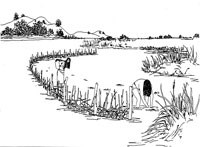
Most of the recorded use of the Boston Harbor Islands for fishing occurred in the 19th century. Fish were reportedly dried on Bumpkin in the early years of the century (Snow 1971:183), but more common were the settlements of fishermen on various islands. These included a colony of fishermen on Middle Brewster from about 1840 to the early 1880s (Sweetser 1988 [1888]:248); a settlement of Portuguese fishermen on the east side of Long from the 1850s to 1887 after which they relocated on Peddocks East and then Middle Heads (Seasholes and Binzen 2008:102–3); one lobsterman on Outer Brewster in the early 1860s (Snow 1971:248; Sweetser 1988 [1888]:250); and, in 1882, a half dozen lobstermen on Calf, several fishermen on Hangman, and three fishermen on Nut (Sweetser 1988 [1888]:254, 214, 211). In the late 19th and early 20th centuries a Portuguese lobsterman lived on Quarantine Rocks off Rainsford (Claesson and Carella 2002:211); about 1905 two lobstermen moved to Green; and in the same period lobstermen and clammers operated on Snake (Snow 1971:247, 148). Bumpkin was reportedly a smelting center in the early 20th century, the smelts harvested in the eel grass off the island and all the way out to Boston Light (Snow 1971:187, 191). The Boston Harbor Islands and in Maine there was a shift to lobstering in the second half of the 19th century. 
The most prevalent historical resources associated with fishing on the Boston Harbor Islands are the habitations of fishermen. Remains of these habitations are known to exist on some islands—Middle Brewster, where the fishermen’s houses were reportedly later converted to summer vacation cottages, Calf, Rainsford, and Green—and their location is known on other islands, such as Long and Outer Brewster. Some actual fishermen’s houses may even still exist on Peddocks where two of the houses on the southwest shore of East Head and some of those on Middle Head are reportedly former Portuguese fishermen’s dwellings (Seasholes and Binzen 2008:103–4, 139–40, 142). Far fewer historical resources on the island are associated with fishing itself. It is assumed that no evidence remains of the 17th-century fish stage on Lovells, if it did, in fact, ever exist. Also problematic is possible evidence of fish drying on Bumpkin in the early 19th century. The early 20th-century smelting center on Bumpkin, however, is sufficiently recent that evidence of it may still be extant. Prepared by Nancy S. Seaholes, 2009 References |
Last updated: February 26, 2015
